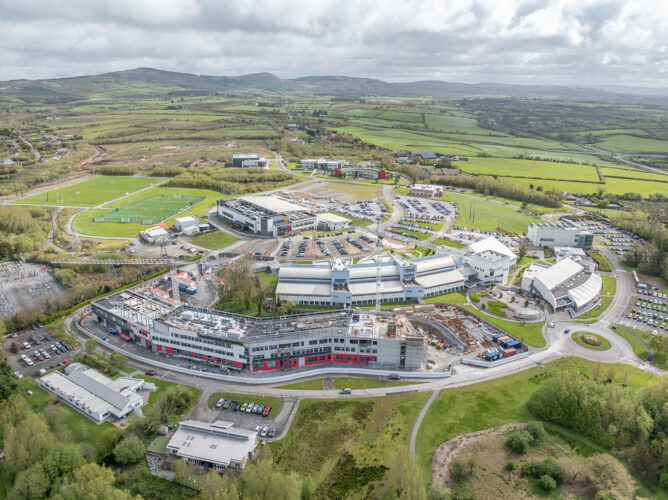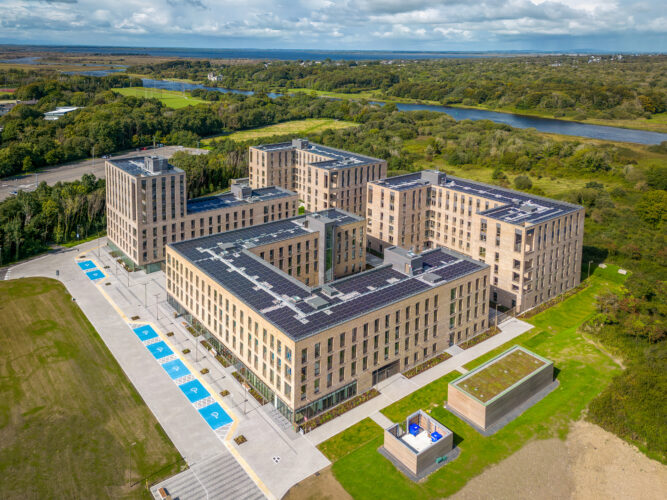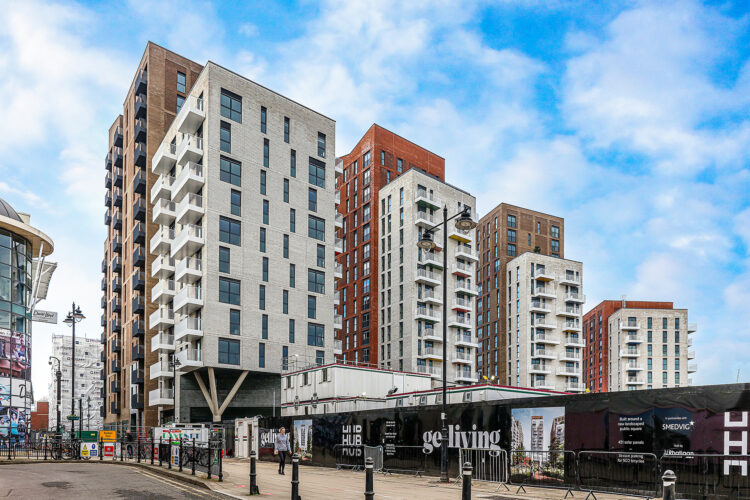16.07.2024 / Main Category
Leading the Successful Delivery of Commercially Challenged Projects
JJ Rhatigan CEO, Ger Ronayne, discusses
the contractor’s pre-construction approach
to extracting greater GDV.
WITH EMPLOYEE numbers approaching 450, and a doubling of team size across the UK, in line with turnover and current pipeline, there is a palpable momentum building within JJ Rhatigan (JJR) right now. Well known in Ireland for delivering education and higher education projects at scale, including the delivery of large-scale, mid-rise student accommodation, the team on the ground in the UK is currently delivering close to 3,000 residential units for the private sector.
From a vantage point of delivering large-scale construction projects across both Ireland and the UK, this construction leader is advocating for a change in how projects are procured, designed and delivered in Ireland.
A NEW MODEL OF PROJECT DELIVERY FOR IRELAND
While the differences between project delivery in Ireland and the UK can be nuanced and subtle from the outside, these differences – when leveraged and managed correctly – can have a huge impact on the speed and quality of delivery, from design and planning, right through to successful handover.
“We have a wealth of expertise not just in the actual construction, but in getting projects to the point of construction, while still achieving ESG targets.”
“Through projects across Ireland and the UK, we have amassed a huge amount of design and build experience. We have a very strong capability in design management, which is particularly relevant for the environment in which we are currently operating, where many UK projects are commercially challenged from a developer’s perspective – as they are in Ireland right now,” explains Ger. Recognising the commercial challenges and addressing these head-on can set a project on the right track for successful delivery.
Ger talks through the project experiences over recent years that have helped the JJ Rhatigan team to perfect a pre-construction modus operandi of working to a budget, fine-tuning a design, and fine-tuning specification. This collaborative process involves working through design and budget challenges with a developer over several months, including an exploration of the right methodology of construction. This approach ensures a budget and scope that works for both parties, derisking the project from a programme perspective and derisking it from a commercial perspective. It also brings early certainty to the specification and to the design, typically optimising and adding value to the overall development.
“We have a wealth of expertise not just in the actual construction, but in getting projects to the point of construction, while still achieving ESG targets. In fact, one project that we completely re-engineered added about £5m GDV (Gross Development Value) by increasing floor area and utilising more commercial space, which actually made the project more viable from the developer’s perspective.”
MODERN METHODS OF CONSTRUCTION VS. THE RIGHT METHODOLOGY
JJ Rhatigan is an early member of MMC Ireland and has been driving the use of offsite and other modern methods of construction in Ireland over the past decade, starting with 3D volumetric bathroom pods, and now increasing the use of 2D panelised systems. Most recently, the contractor is exploring the use of mechanical and electrical, or M&E pre-fabricated utility cupboards to speed up project delivery. According to Ger, offsite fabrication suits many projects in Ireland, reducing the time and labour onsite; but this is not universal. Ger advocates for the right methodology for the project in hand, recognising the capabilities and capacity across the supply chain. By way of example, he cites a number of UK projects and how a more traditional approach proved to be the right construction methodology, noting the UK supply chain’s strong track record for in-situ concrete over precast. Again, it is about selecting the right construction methodology for the project in hand in order to optimise the design and achieve programme success.

€252m Higher Education Bundle 1 on MTU campus Tralee – one of 6 facilities at Technological Universities nationwide.
MAXIMISING GDV
Speaking about the economic and industry pressures driving changes to how projects must be delivered, Ger is clear that the main challenge is that the value of these developments is simply too close to the cost of construction. While this is more pronounced in commercial projects, residential delivery is also subject to these pressures. Acknowledging that the cost of construction is too high in relation to the value of the projects, Ger points out that, traditionally, the dynamics of supply and demand would have resolved that issue, resulting in an increased value of the end development. However, this is not working in the current marketplace, as to increase end value is to make the end product unaffordable. This is true for homes intended for consumer sale and for those intended for the PRS market. Therefore, better value must be extracted from the construction process. But, as Ger explains about the lean approach, “you can only cost-cut your way to so much”, achieving programme certainty through pre-construction fine-tuning is a more credible route to achieving development viability, while still ensuring the environmental performance of the building.
So, accepting that construction costs in Ireland are too high right now, how does that differ to the UK? According to Ger, the situation for UK project delivery is all too similar, with the cost of finance emerging as a real threat to development. But there are some significant differences.
“For UK projects, we are generally able to sit down with the developer at an early stage (in full negotiation or sometimes from a two-stage selection process), and very quickly get to a point where we’re having a mature conversation about budget and what our high-level cost plan tells us is realistic. From this point, we agree to work together for a number of months, through a formal pre-construction services agreement, whereby we manage the design team and set about interrogating the project so that we can reshape it and optimise it, with full involvement from the developer, to achieve and ensure viability.”
Maximising GDV is key. For a commercial unit, that means ensuring every possible square foot is within the lettable area. For residential developments, it is about fine-tuning the sizes of the apartments, and perhaps introducing an extra number of units, before looking at the specifications and possible savings. All of this is done with a view to optimising the overall development value in a way that aligns with the end user, whether that’s for the sales or PRS market, in the affordable, mid or high-value range. By working through every minute aspect of the project, from site investigation, down to the interior designer’s choice of tiles and other fixtures and fittings, the JJ Rhatigan team is effectively derisking every possible element of the project.

Dunlin Village, University of Galway.
DERISKING PROJECT DELIVERY
The entire pre-construction process is an exercise in risk identification, risk allocation, and indeed, risk management. While risk cannot ever be completely eliminated, Ger is confident that the JJR approach takes his team close to this. And through appropriate risk allocation strategies, any remaining risk is diversified across the project delivery team and supply chain, ensuring it sits with the individuals or the companies that are best placed to manage it.
In terms of risk profile, this is a key difference that Ger notes between project 69delivery in the UK and in Ireland. He gives the example of being able to transfer risk in the UK to a frame contractor or to a groundworks contractor, knowing they can reasonably manage it and, if some of the risk materialises, that they are actually in a position to absorb it. Whereas that would not necessarily be the case in Ireland. That is a significant difference that can materially impact the delivery of a project in Ireland, compared with a similar project in the UK. Despite these differences, Ger is adamant that the company’s pre-construction approach can and will work in the Irish market. In the meantime, he acknowledges that the design team will need to “get into the weeds” to a greater extent in order to work through that process with the local supply chain.

One Maidenhead, Mixed-Use Development, London.
“It’s very much a partnership approach. There needs to be recognition on the developer side of the value of being upfront and establishing the real cost, knowing that at some point, we are going to reap a margin on that. It’s transparent. Critically, we are passing the value that we’re obtaining through the pre-construction process onto the developer, which can be the difference in making a development viable. And we’ve done that successfully on a number of occasions. In our experience, a big part of making projects viable is taking the risk out and reducing the need for any significant contingencies.”
Due to an expanding pipeline, JJ Rhatigan is currently growing its team with a number of senior roles now available www.jjrhatigan.com/current-opportunities/

